Title page
Copyright
Dedication
Preface
Overview
Organization of the Book
Acknowledgments
About the Author
Chapter 1. Introduction
1.1 Motion perception
1.2 The heritage of animation
1.3 Animation production
1.4 Computer animation production
1.5 A brief history of computer animation
1.6 Summary
References
Chapter 2. Technical Background
2.1 Spaces and transformations
2.2 Orientation representation
2.3 Summary
References
Chapter 3. Interpolating Values
3.1 Interpolation
3.2 Controlling the motion of a point along a curve
3.3 Interpolation of orientations
3.4 Working with paths
3.5 Chapter summary
References
Chapter 4. Interpolation-Based Animation
4.1 Key-frame systems
4.2 Animation languages
4.3 Deforming objects
4.4 Three-dimensional shape interpolation
4.5 Morphing (two-dimensional)
4.6 Chapter summary
References
Chapter 5. Kinematic Linkages
5.1 Hierarchical modeling
5.2 Forward kinematics
5.3 Inverse kinematics
5.4 Chapter summary
References
Chapter 6. Motion Capture
6.1 Motion capture technologies
6.2 Processing the images
6.3 Camera calibration
6.4 Three-dimensional position reconstruction
6.5 Fitting to the skeleton
6.6 Output from motion capture systems
6.7 Manipulating motion capture data
6.8 Chapter summary
References
Chapter 7. Physically Based Animation
7.1 Basic physics—a review
7.2 Spring animation examples
7.3 Particle systems
7.4 Rigid body simulation
7.5 Cloth
7.6 Enforcing soft and hard constraints
7.7 Chapter summary
References
Chapter 8. Fluids: Liquids and Gases
8.1 Specific fluid models
8.2 Computational fluid dynamics
8.3 Chapter summary
References
Chapter 9. Modeling and Animating Human Figures
9.1 Overview of virtual human representation
9.2 Reaching and grasping
9.3 Walking
9.4 Coverings
9.5 Chapter summary
References
Chapter 10. Facial Animation
10.1 The human face
10.2 Facial models
10.3 Animating the face
10.4 Lip-sync animation
10.5 Chapter summary
References
Chapter 11. Behavioral Animation
11.1 Primitive behaviors
11.2 Knowledge of the environment
11.3 Modeling intelligent behavior
11.4 Crowds
11.6 Chapter summary
References
Chapter 12. Special Models for Animation
12.1 Implicit surfaces
12.2 Plants
12.3 Subdivision surfaces
12.4 Chapter summary
References
APPENDIX A: Rendering Issues
APPENDIX B: Background Information and Techniques
B.1 Vectors and matrices
B.2 Geometric computations
B.3 Transformations
B.4 Denevit and Hartenberg representation for linked appendages
B.5 Interpolating and approximating curves
B.6 Randomness
B.7 Physics primer
B.8 Numerical integration techniques
B.9 Optimization
B.10 Standards for moving pictures
B.11 Camera calibration
Index
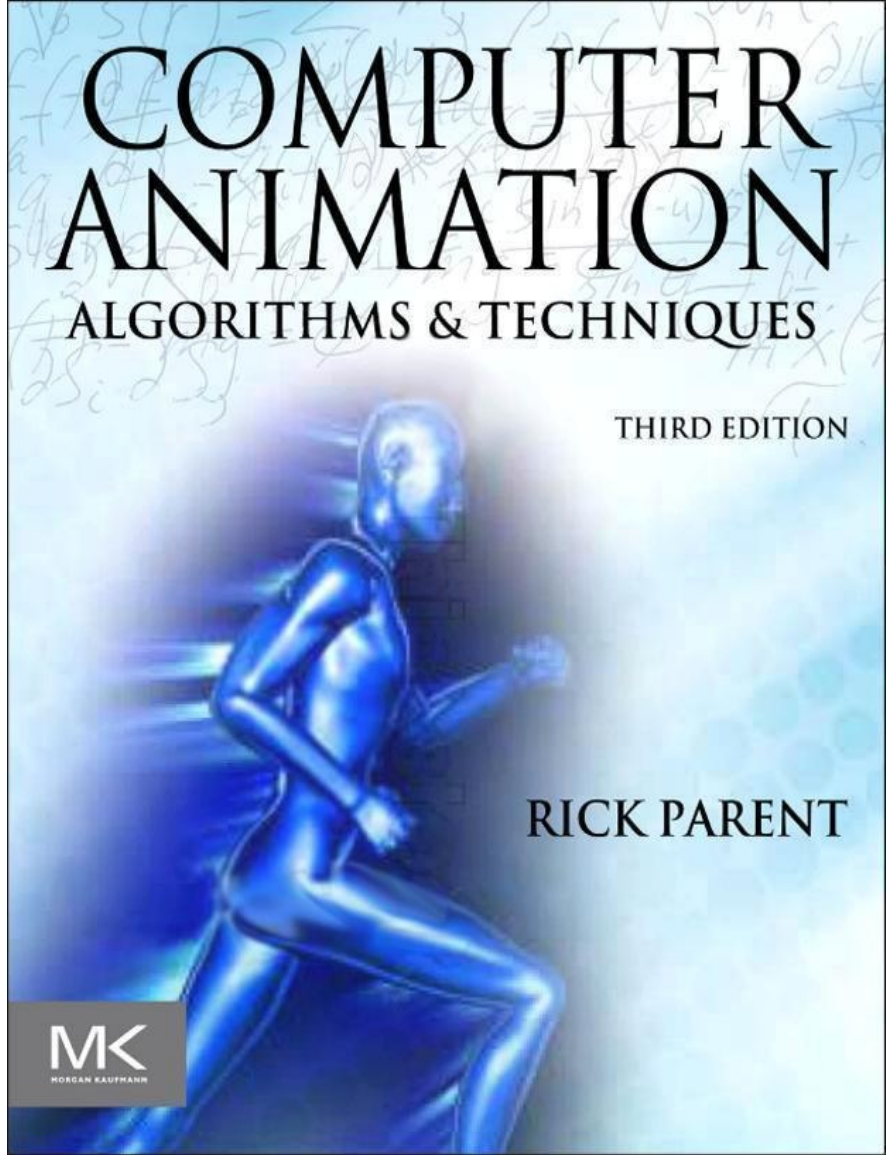
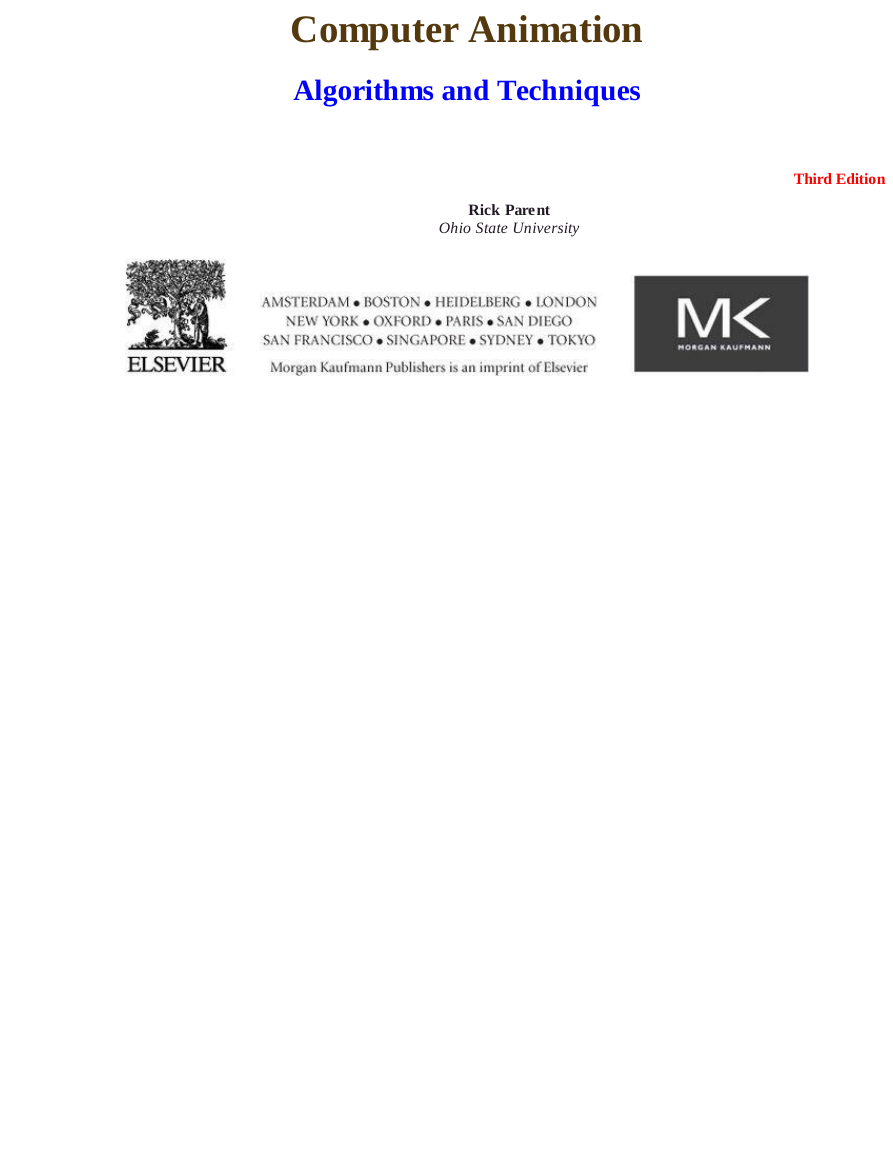

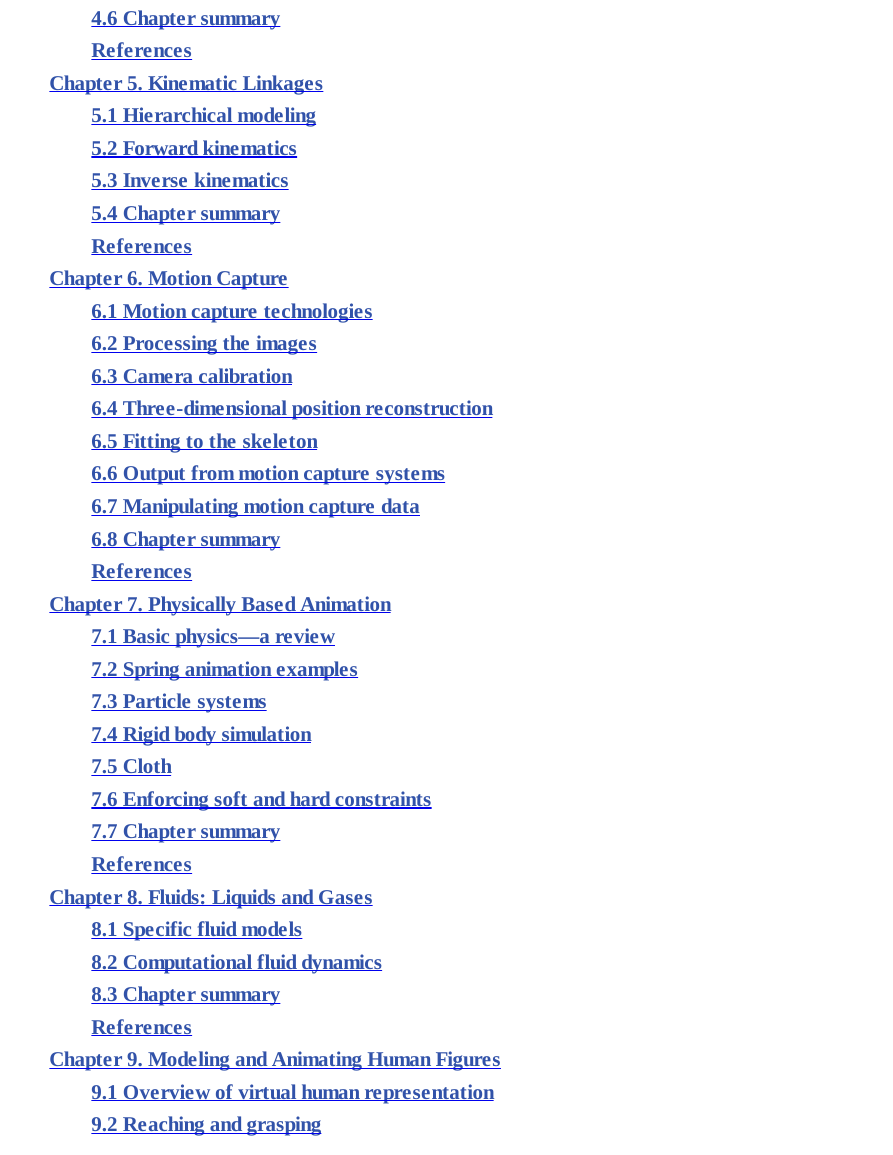
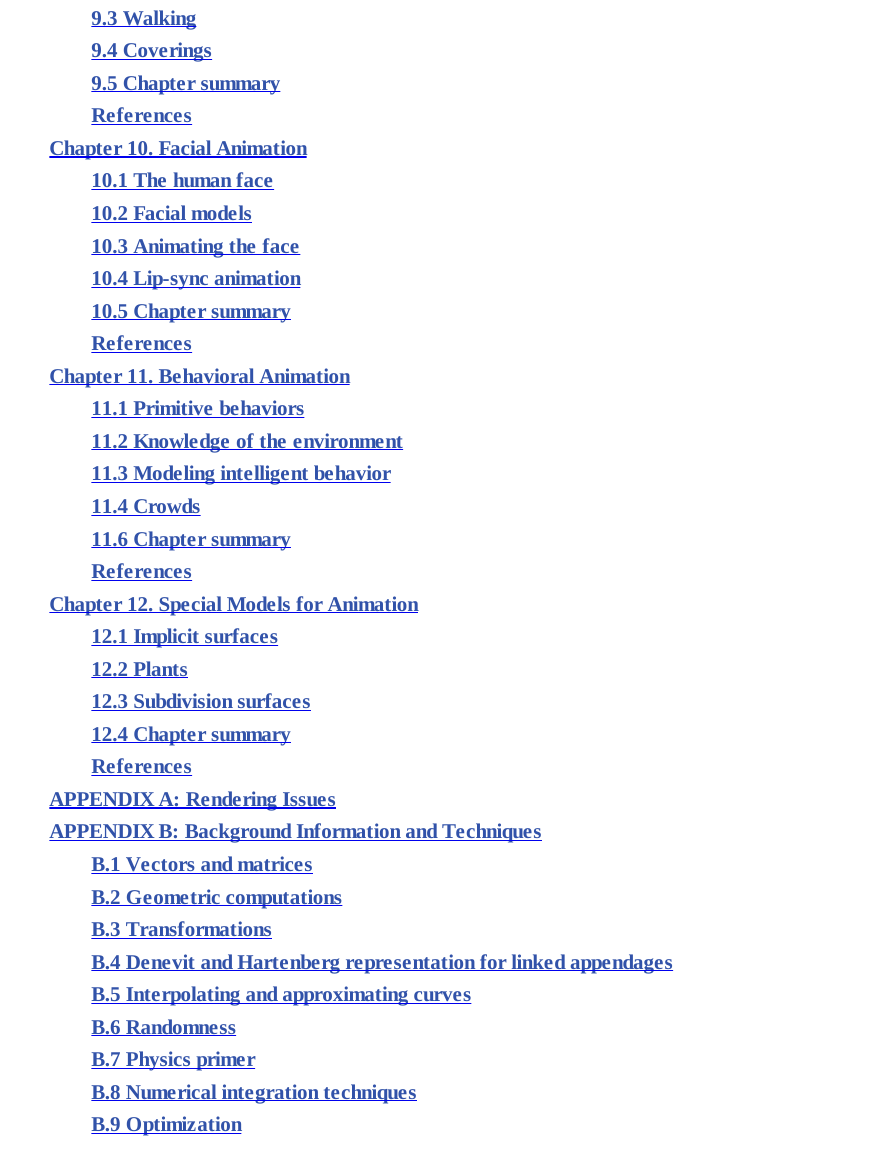

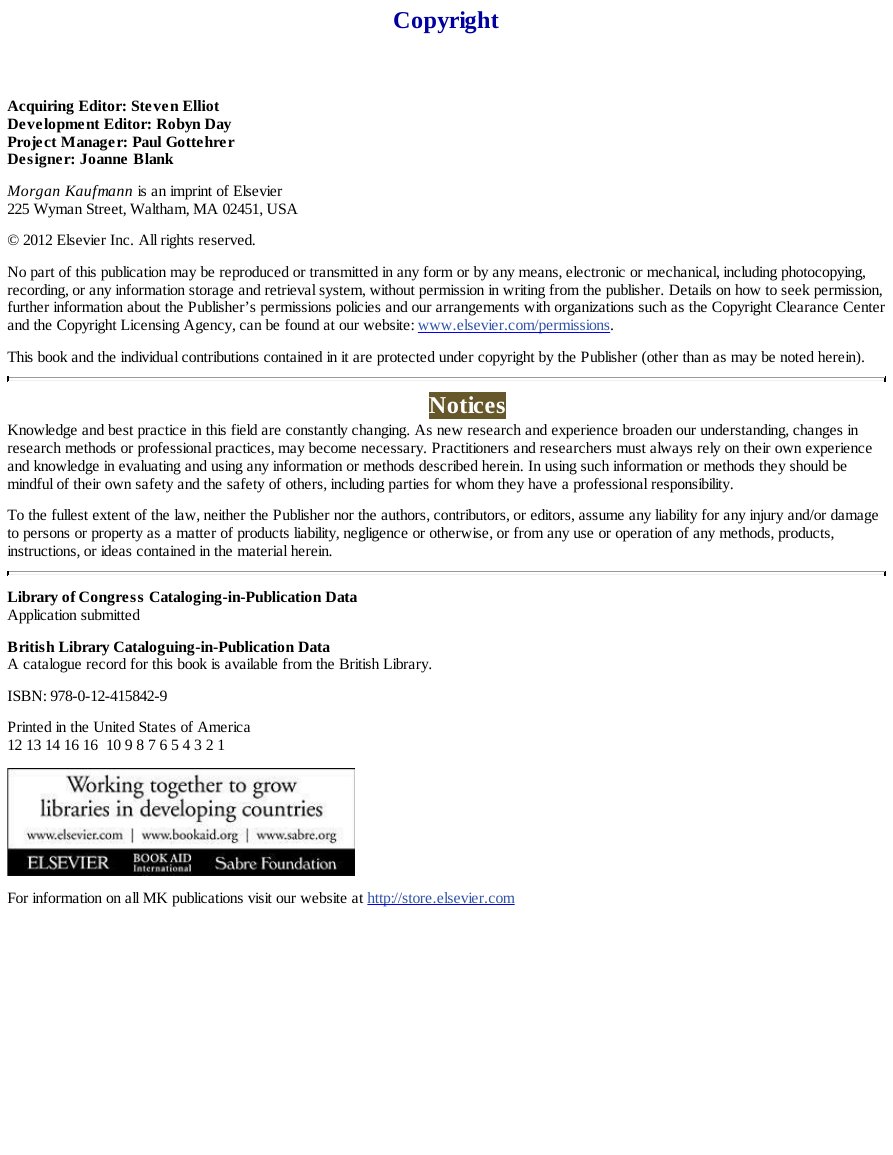









 2023年江西萍乡中考道德与法治真题及答案.doc
2023年江西萍乡中考道德与法治真题及答案.doc 2012年重庆南川中考生物真题及答案.doc
2012年重庆南川中考生物真题及答案.doc 2013年江西师范大学地理学综合及文艺理论基础考研真题.doc
2013年江西师范大学地理学综合及文艺理论基础考研真题.doc 2020年四川甘孜小升初语文真题及答案I卷.doc
2020年四川甘孜小升初语文真题及答案I卷.doc 2020年注册岩土工程师专业基础考试真题及答案.doc
2020年注册岩土工程师专业基础考试真题及答案.doc 2023-2024学年福建省厦门市九年级上学期数学月考试题及答案.doc
2023-2024学年福建省厦门市九年级上学期数学月考试题及答案.doc 2021-2022学年辽宁省沈阳市大东区九年级上学期语文期末试题及答案.doc
2021-2022学年辽宁省沈阳市大东区九年级上学期语文期末试题及答案.doc 2022-2023学年北京东城区初三第一学期物理期末试卷及答案.doc
2022-2023学年北京东城区初三第一学期物理期末试卷及答案.doc 2018上半年江西教师资格初中地理学科知识与教学能力真题及答案.doc
2018上半年江西教师资格初中地理学科知识与教学能力真题及答案.doc 2012年河北国家公务员申论考试真题及答案-省级.doc
2012年河北国家公务员申论考试真题及答案-省级.doc 2020-2021学年江苏省扬州市江都区邵樊片九年级上学期数学第一次质量检测试题及答案.doc
2020-2021学年江苏省扬州市江都区邵樊片九年级上学期数学第一次质量检测试题及答案.doc 2022下半年黑龙江教师资格证中学综合素质真题及答案.doc
2022下半年黑龙江教师资格证中学综合素质真题及答案.doc